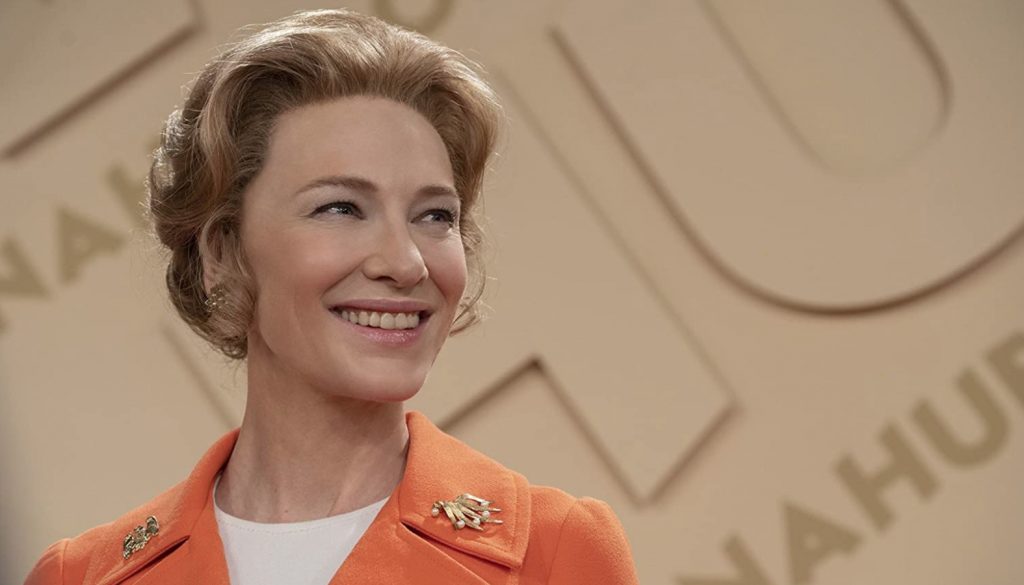It started as a debate over “equality of rights under the law” between men and women. But before long, it became a heated political dogfight that came to epitomize the culture wars of 1970s America: the saga of the Equal Rights Amendment (ERA).
The passion, confusion, and turmoil of that time is retold in a new historical drama miniseries, “Mrs. America,” which dives into the story of the ERA, a flagship initiative of the feminist movement, and the opposing movement led by Illinois wife and mother Phyllis Schlafly (Cate Blanchett).
The story has become newly relevant ever since a handful of states have ratified the amendment, which Congress passed in 1972, within the past three years. Because the 1982 ratification deadline has long since passed, and because several states have rescinded their approval, the status of the amendment remains unclear. Still, its recent revival has turned the spotlight back on the women’s liberation movement and the goals that have driven it for decades.
As a drama, “Mrs. America” is a work of art. It offers captivating characters, a tight and punchy script, and a vivid panorama of 1970s America.
As a historical piece, it crumbles.
This should not come as a surprise: The progressive feminist movement is far too powerful — and Phyllis Schlafly far too hated — to offer an unbiased account of her character and cause.
To its credit, what makes “Mrs. America” stand out is its in-depth portrayal of the two opposing women’s campaigns and their leaders. Schlafly, the show’s title reference and primary protagonist, is anything but a flat character. Indeed, she displays several likable (dare I say, feminist?) qualities: She is confident, sharp, and unafraid to speak her opinion in any circumstance. As a well-established wife and mother of six, she pours all her energy and skill into preserving the world she holds dear.
Her nemesis, the unabashedly unmarried Gloria Steinem (Rose Byrne), is young, irreverent, and nonchalant in the spotlight. As the celebrated epitome of a “liberated woman,” she fights tooth and nail to push the feminist agenda forward and make “reproductive freedom” a reality.

Both of these women and their cohorts are brought to life as dynamic characters. In doing so, “Mrs. America” invites viewers to contemplate each side and even sympathize with them, whatever their own beliefs might be.
It’s an admirable plan, but the execution proves unsatisfying. The slant is subtle, but that very subtlety makes it so potent. Schlafly might have the honor of the title role, but the show does not actually honor her. She is the protagonist but by no means the heroine. As each episode unfolds, the narrative steadily builds the sensation that Schlafly is, in fact, the villain that the true heroines are destined to defeat.
To convince its audience of this “truth,” the show’s primary strategy is not so much to make Schlafly despicable but to make her feminist counterparts irresistible. A string of choked-up speeches, empathetic exchanges, and tearful memories paint them as wounded warriors fighting for a noble cause. The centerpiece of that cause is abortion. “Mrs. America” uses sentimentality to make abortion the ultimate salvation, and its proponents on par with the abolitionists.
For all of the intricate character building on both sides of the battle, once this point is made manifest, the series collapses into a lazily one-sided story. Steinem and her feminist gang are upheld as the true visionaries, while Schalfly and her crew of homemakers are either too naive or too afraid to shed the security of their oppressed lifestyle.
Even Schlafly doesn’t seem so blissful in her married life. We see her husband doubting her political skill and pressuring her into sex when she’s exhausted and unwilling (a gross misrepresentation of reality, according to Schlafly’s own niece). After peeling back the layers of “Mrs. America,” we find a faux realism that veils a radical feminist fantasy fueled by resentment against Schlafly and her campaign.
Still, as much as the show can discreetly propagandize, it cannot rewrite history entirely. Consciously or not, “Mrs. America” shows how Schlafly’s concerns about the ERA were not unfounded. Even though the amendment did not make it into the Constitution, many of the cultural catastrophes she predicted it would usher in came anyway: the deterioration of the institution of marriage, the dismantling of the traditional family unit, the widespread refusal to have children, and the explosion of abortion.
In the first season alone, “Mrs. America” makes clear that the ERA battle was not really about the ERA at all. If it were, then its innocuous and even praiseworthy wording would stir no controversy whatsoever. Rather, the battle was about what the women’s liberation movement actually stood for, and what its lasting impact on culture aimed to be — and indeed has been.
“Mrs. America” is worth seeing, but not for a history lesson. Watch it for its compelling narrative, fascinating display of strong women at odds, and above all, for its strikingly (if unknowingly) prophetic nature. The ERA may have died, but radical feminism did not, and that makes the debate Schlafly sparked almost 50 years ago just as relevant today.

